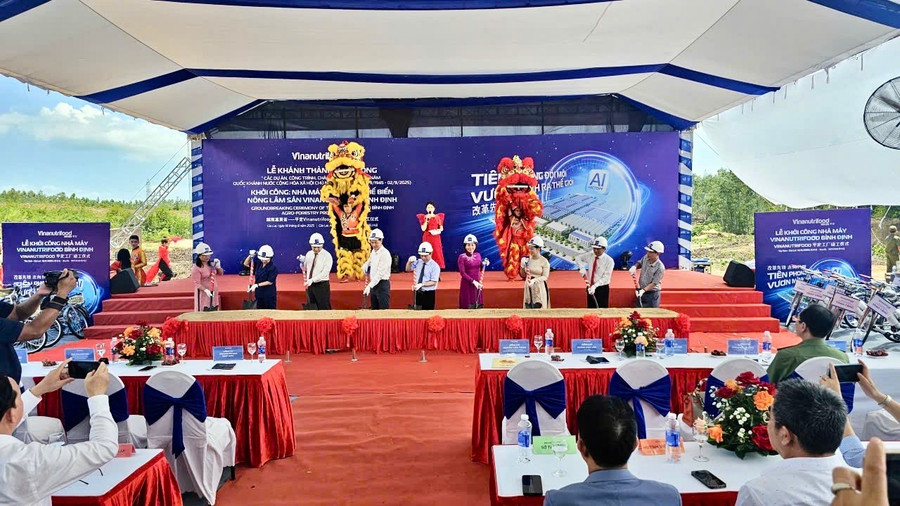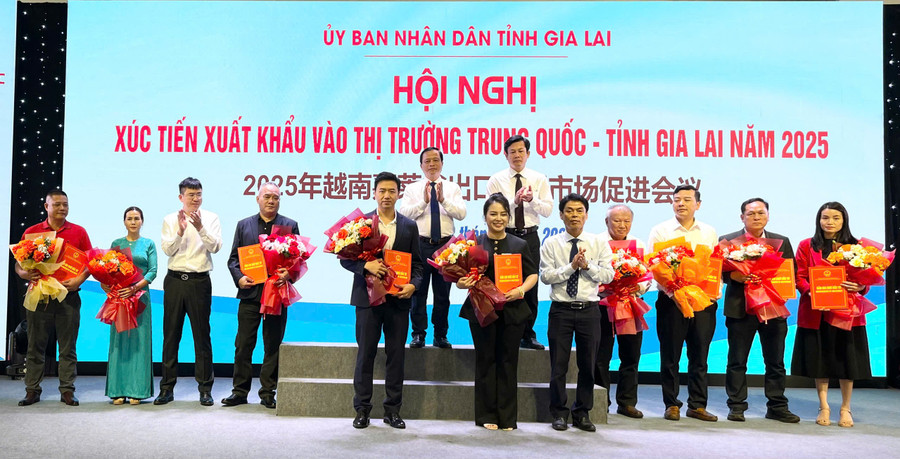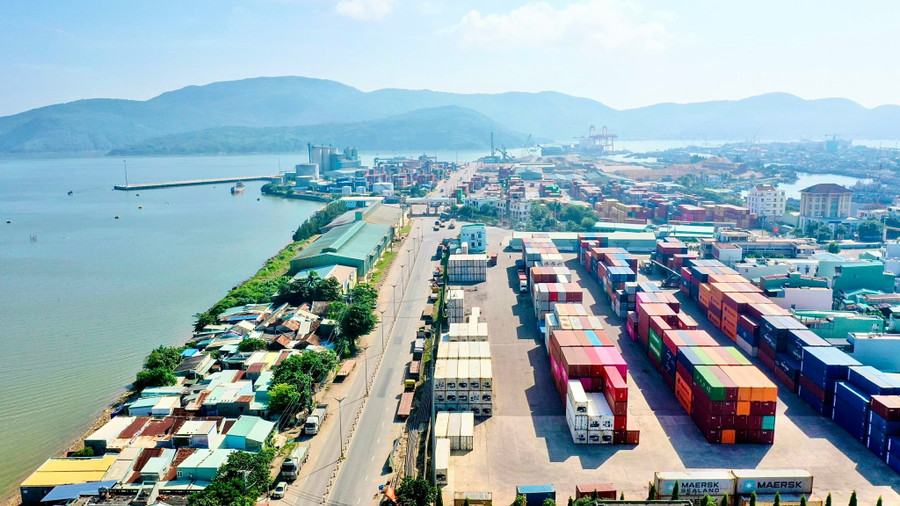Recently, the Vinanutrifood Binh Dinh Concentrated Agricultural and Forestry Products Production and Processing Factory Project was started in Tay Son Commune (Gia Lai Province). The project is deployed on an area of 10 hectares with a total investment capital of nearly 500 billion VND in phase 1. The project pioneers the application of AI in agricultural management, blockchain traceability, aiming to make the entire supply chain transparent, ensuring product supply to many markets around the world.
On this occasion, Gia Lai Newspaper and Radio and Television reporters had an interview with Ms. Nguyen Thi Diem Hang - Vice President of Vietnam Agricultural Enterprise Council, General Director of Vinanutrifood Binh Dinh Company about this orientation.

Vinanutrifood Binh Dinh. Photo: Duc Hai
AI paves the way for transparent manufacturing
▪ Madam, Vinanutrifood Binh Dinh is applying AI in production. So how effective is this technology for businesses?
- We apply AI to the entire production chain, starting from the raw material area. Currently, many domestic enterprises still produce based on personal experience, with little digital application, low efficiency, leading to difficulty in replication.

With a raw material area of 1,000-2,000 hectares or more, we are required to apply AI technology to management.
AI helps predict epidemics and natural disasters. For example, when there is a storm, the system will give specific forecasts about the impact on each type of crop, thereby helping us proactively prevent it.
On the other hand, AI also controls the entire process from seeds, soil, fertilizers, irrigation water, and care techniques. All are digitized and information is integrated into the blockchain system to ensure transparency.
Customers and international partners only need to scan the QR code to access full information about which tree the product is grown on, which plot of land, and the care process.
This is the outstanding advantage of AI technology in product transparency, meeting the strict requirements of the international market, creating trust for consumers.
▪ So, can AI solve the "bottleneck" in agricultural production?
- Yes. AI helps to closely control the raw material area, production process and to the consumer. Buyers know clearly how the product they use is grown, processed and reaches them.
We have witnessed many shipments arriving at the border gate, but when tested, the results were different, even though they had the same growing area code and packaging code, causing difficulties for businesses.
With AI technology, the Company focuses on transparency and process management using technology from farmers to factories, ensuring consistency, transparency and more accurate yield forecasting.
Along with that, we also aim to form a smart production-business ecosystem in the future.

Photo: Vu Thao
In particular, IoT applications automate from data collection to optimizing production processes, reducing operating costs; camera surveillance systems in large raw material areas; at the same time, coordinate with the Department of Agriculture and Environment of Gia Lai to convert ineffective crops to crops with high economic value.
For example, in Kbang, low-yield sugarcane areas will be converted to coconut and fruit trees intercropped with medicinal plants. This model not only increases short-term income but also ensures long-term benefits for farmers.
Post-merger advantages to boost exports
▪ In which areas will the business focus on expanding raw material areas, madam?
- In the immediate future, we will prioritize large raw material areas near the factories in the old Gia Lai and Binh Dinh provinces, then gradually expand. The Company will purchase directly agricultural products that are already grown stably by the people such as durian, banana, and coffee.
As for ineffective crop areas and crops with unstable output, we will focus on converting and working with farmers to gradually form sustainable raw material areas, linked to product consumption.
▪ After Gia Lai and Binh Dinh merged, what do businesses expect from the new province's policies?
- I think this is a strategy that demonstrates the Government's vision. The old Gia Lai has the advantage of a large raw material area, while the old Binh Dinh has a logistics system and seaports that are favorable for export, creating a double advantage for the new Gia Lai province. This is an important factor to combine to create a complete value chain for agricultural products.
However, the biggest bottleneck today is logistics. Logistics costs currently account for a large proportion of product costs.
If we can take advantage of the seaport and logistics infrastructure, especially the planning of Phu My port area, we will remove transportation bottlenecks and expand export markets. The province merger strategy will create a new development step, especially in the field of high-tech agriculture and deep processing agriculture.
▪ What recommendations do you have for the province in developing logistics infrastructure?
- The distance from the western regions to the seaport is only over 100 km, but the travel time is still too long, causing high logistics costs. Agricultural products need the most speed of transportation to ensure quality.
For a long time, we have been stuck with the story of having a large raw material area but being stuck in the transportation stage. I hope that the province and the ministries and branches will soon adjust the traffic speed regulations, upgrade the main routes, so that the travel time will be shortened to only about 2 hours for the goods to reach the port.

In particular, when the Quy Nhon-Pleiku expressway starts construction next October, we expect it to be a big boost. The expressway will help reduce logistics costs by 30%, creating conditions for Gia Lai's "king" agricultural products such as coffee, pepper, durian, banana, coconut, etc. to reach the world market.
▪ According to you, in investment cooperation connection, what policies does the province need to create momentum?
- I hope the province will review, reclaim or restructure land funds allocated to businesses but not yet exploited effectively, and hand them over to units that operate seriously and apply high technology. Agriculture now cannot rely on old farming methods. If we do not boldly innovate and apply technology, we will have difficulty competing.
We are ready to invest in building large model fields of thousands of hectares, applying mechanization and digital technology, improving productivity, reducing costs, and bringing Gia Lai agricultural products to the world.
▪ Thank you!
Source: https://baogialai.com.vn/ung-dung-ai-de-minh-bach-hoa-san-xuat-nong-nghiep-post565495.html





![[Photo] 60th Anniversary of the Founding of the Vietnam Association of Photographic Artists](/_next/image?url=https%3A%2F%2Fvphoto.vietnam.vn%2Fthumb%2F1200x675%2Fvietnam%2Fresource%2FIMAGE%2F2025%2F12%2F05%2F1764935864512_a1-bnd-0841-9740-jpg.webp&w=3840&q=75)

![[Photo] National Assembly Chairman Tran Thanh Man attends the VinFuture 2025 Award Ceremony](/_next/image?url=https%3A%2F%2Fvphoto.vietnam.vn%2Fthumb%2F1200x675%2Fvietnam%2Fresource%2FIMAGE%2F2025%2F12%2F05%2F1764951162416_2628509768338816493-6995-jpg.webp&w=3840&q=75)








































































































Comment (0)